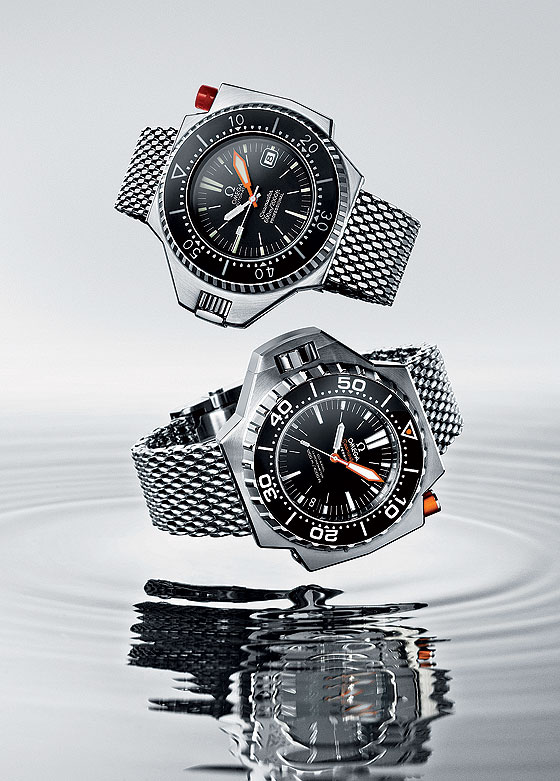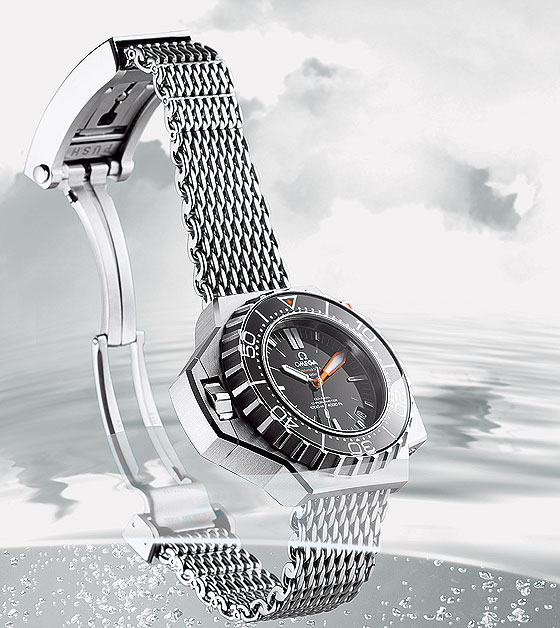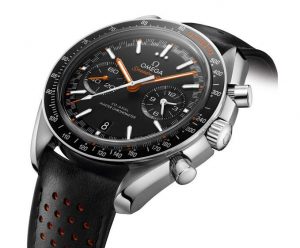
It was 1970, in the midst of an era that delighted in unusual shapes and bright colors, when Omega first released the attention-getting Seamaster Professional 600m, nicknamed the Ploprof. The watch, designed in collaboration with the French industrial diving company Comex, was conceived for professional use: the name “Ploprof” stands for plongeurs professionels, or professional divers. While Omega emphasized its functions, the model perfectly suited the styles of the 1970s, with a gigantic and unusually shaped case, a red button to unlock the divers’ bezel, a bright orange strap and a minute hand of the same color.
The Ploprof achieved fame in the wake of the spectacular underwater missions in which it participated. The most important of these was the Janus Program, with which Comex tested saturation diving for the Elf petroleum company. Three divers manned a pressured chamber 200 meters below the surface of the Gulf of Ajaccio, off Corsica, for eight consecutive days, during which they worked on the seafloor at 250 meters’ depth for up to six hours each day, setting a new depth record. Rolex at this time was experimenting with the helium valve, which it used for the first time in the Sea-Dweller in 1971, but Omega pursued a different strategy with its Ploprof: the case was constructed and insulated so that helium atoms couldn’t penetrate it during the saturation dive, preventing the danger of explosion during the subsequent decompression.
A nearly 0.5-cm-thick sapphire crystal ensures adequate resistance to pressure on the front of the case, enabling the Ploprof to withstand pressures equivalent to those found 1,200 meters underwater. Thanks to the case’s new construction, with its removable back, the Ploprof now also has an automatic helium valve so professional divers can wear it during saturation dives. The valve is positioned on the underside of the orange button’s outrigger and marked with the chemical abbreviation “He” (for helium) beneath a coating of clear lacquer. The case is very well crafted; the beveled and polished edges contrast beautifully with the other surfaces, which have a matte-brushed finish.

Omega also revives the Milanese (what it calls “sharkproof”) bracelet, a woven-steel type that was popular in the 1970s. This one has individual links on the clasp, like a conventional steel bracelet, so it can be conveniently shortened and lengthened. The bracelet is very well crafted — very supple and entirely without sharp edges or corners.
The folding clasp on the Milanese bracelet is pleasantly user-friendly. Two large buttons make it easy to open the clasp; just apply pressure gently with your thumb to slide out the built-in extension mechanism to a maximum length of 26 millimeters. Afterward, and also after having reclosed the clasp, the bracelet can be shortened in single-millimeter increments until it fits snugly but comfortably around its wearer’s wrist. If an even longer bracelet is needed to wear outside the sleeve of a diving suit, the added 22-mm extension piece can be folded out of the clasp. The entire system is very well thought out, extremely sturdy, and very simple to operate. Furthermore, the massive clasp with its beveled and polished edges perfectly matches the Ploprof’s case.
The redesigned bracelet increases the wearing comfort of the new Ploprof, despite the watch’s heavy weight of 279 grams and brawny overall width of 55 millimeters. However, the raised relief of the seahorse emblem and stripes on the caseback presses somewhat uncomfortably against the wrist. The new model, like its 1970s predecessor, is also available with either an orange or a black strap. The modern strap is made of rubber and goes well with the watch’s styling, but it offers very little counterweight to the heavy case and makes the watch look top-heavy on the wrist.
All in all, Omega has succeeded in adapting a charming 1970s design for contemporary audiences without making the watch look old-fashioned or inappropriate. Many small details were taken into consideration for this update: the raised bars on the flanks of the crown and bezel are polished while the lower-lying interstitial spaces are matte. Other fine details, such as the applied indices, also contribute to the watch’s luxurious look. In a nutshell: good retro design that satisfies modern demands.
The Ploprof’s interior is decidedly modern, as well. Inside its big case is automatic Caliber 8500, Omega’s first manufacture-developed base caliber from 2007, which has now been equipped with the improved co-axial escapement. The movement was constructed around the co-axial escapement and leaves sufficient space for its escape wheel to work with greater efficiency on three levels rather than only two. The balance is held in place not by a cock affixed on one side, but by a bridge that’s firmly screwed on two sides. This not only provides better protection against impacts, but also makes it possible to adjust the vertical play with greater precision, which in turn improves the accuracy of the rate. The balance spring breathes freely thanks to fine adjustment via weight screws on the rim of the balance, which swings at the unconventional frequency of 25,200 semi-oscillations per hour (3.5 hertz). The new Nivachoc shock absorption improves the centering of the balance pinion, which is also especially thin at the pivots to reduce positional error in the bearings. The movement holds a lengthy power reserve of 60 hours. The bidirectional winding rotor runs in a sliding bearing and winds two serially switched barrels. Thirty-nine jewels (out of a total 202 total components in Caliber 8500) minimize friction.
The decorations suit the movement’s modern architecture: the balance is coated with a layer of black chrome, the two barrels are coated with black DLC, and several screws are also blackened. Geneva waves, expanding outward in a spiral pattern, are the sole decorative engraving.







